The Injectable Nanomedicines Market is estimated to be valued at USD 20.4 billion in 2025 and is projected to reach USD 64.6 billion by 2035, registering a compound annual growth rate (CAGR) of 12.2% over the forecast period.
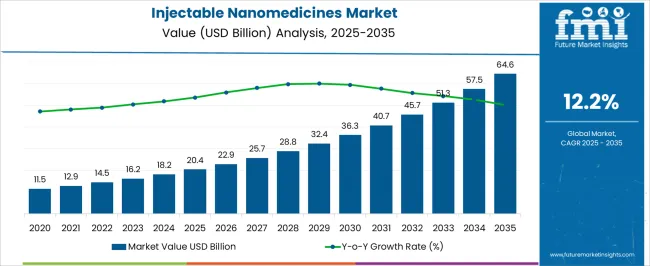
| Metric | Value |
|---|---|
| Injectable Nanomedicines Market Estimated Value in (2025 E) | USD 20.4 billion |
| Injectable Nanomedicines Market Forecast Value in (2035 F) | USD 64.6 billion |
| Forecast CAGR (2025 to 2035) | 12.2% |
The Injectable Nanomedicines market is experiencing steady expansion due to increasing demand for advanced drug delivery systems capable of enhancing therapeutic efficacy and minimizing side effects. The market growth is being driven by the rising prevalence of chronic diseases, particularly cancers, and the need for targeted treatment solutions that improve patient outcomes. Nanomedicine platforms are allowing precise delivery of active pharmaceutical ingredients, controlled release, and enhanced bioavailability, which has made them highly attractive to both healthcare providers and patients.
Ongoing research and development efforts are facilitating the development of novel nanoparticle formulations, enabling customization for specific disease applications. Investments in hospital infrastructure and the growing adoption of advanced therapies in clinical practice are further supporting the market growth.
Additionally, the potential for reduced systemic toxicity and improved patient adherence is encouraging wider utilization of injectable nanomedicines As healthcare systems continue to focus on personalized medicine and more effective therapeutic interventions, the market is expected to maintain a robust growth trajectory, with expanding opportunities across oncology and other high-burden disease areas.
The injectable nanomedicines market is segmented by drug type, application, end user, and geographic regions. By drug type, injectable nanomedicines market is divided into Liposomes, Micelles, Nanocrystals, Polymeric Nanoparticles, Metallic Nanoparticles, Mesoporous Silica Nanoparticles, and Others.
In terms of application, injectable nanomedicines market is classified into Cancers, Central Nervous System Diseases, Cardiovascular diseases, Infection Control, Inflammatory Diseases, and Others. Based on end user, injectable nanomedicines market is segmented into Hospitals, Ambulatory Surgical Center, Clinics, Specialized Drug R&D institutes, and Managed Care Organizations.
Regionally, the injectable nanomedicines industry is classified into North America, Latin America, Western Europe, Eastern Europe, Balkan & Baltic Countries, Russia & Belarus, Central Asia, East Asia, South Asia & Pacific, and the Middle East & Africa.
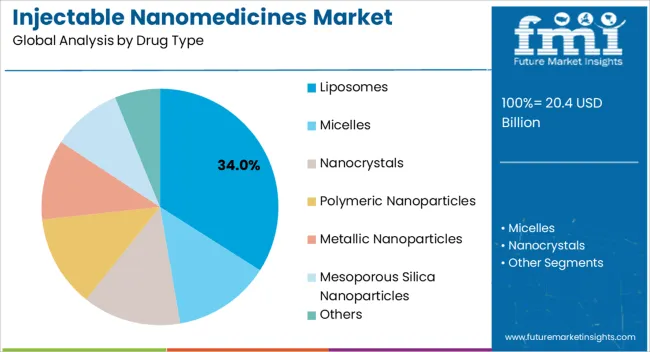
The Liposomes drug type is projected to hold 34.00% of the overall Injectable Nanomedicines market revenue share in 2025, making it the leading segment among drug types. This position has been driven by the unique ability of liposomes to encapsulate both hydrophilic and hydrophobic drugs, providing controlled and targeted delivery to specific tissues while minimizing systemic exposure. Liposomes are widely utilized in cancer therapy due to their enhanced permeability and retention effect, which allows preferential accumulation in tumor tissues.
The growth of this segment has also been supported by the increased clinical adoption of liposomal formulations for chemotherapy, immunotherapy, and combination therapies. Additionally, liposomes are compatible with scalable manufacturing processes and allow surface modification to improve circulation time and targeting accuracy.
Their versatility in delivering a wide range of therapeutic molecules without major safety concerns has positioned liposomes as the preferred choice for injectable nanomedicines Ongoing research focused on enhancing stability, targeting efficiency, and multifunctional payload delivery is expected to further sustain the growth of the liposomes segment in the coming years.
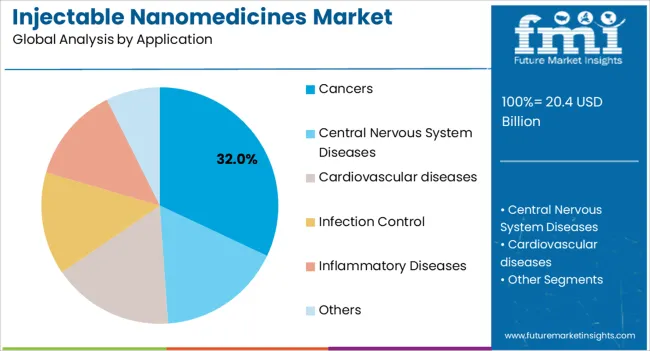
The cancers application segment is expected to account for 32.00% of the Injectable Nanomedicines market revenue share in 2025, making it the leading therapeutic area. This dominance has been attributed to the growing global incidence of various cancers and the pressing need for more effective and targeted treatment modalities. Injectable nanomedicines allow precise delivery of chemotherapeutic and immunotherapeutic agents to tumor sites, improving treatment efficacy while reducing toxicity to healthy tissues.
The increasing prevalence of personalized oncology approaches, combined with the need for combination therapies and controlled release systems, has further reinforced the adoption of nanomedicine platforms in cancer care. Hospitals and research institutions are investing in advanced clinical trials and innovative formulations, which has accelerated the integration of nanomedicines into standard oncology practice.
Enhanced patient outcomes, reduced side effects, and improved drug bioavailability have driven demand in both inpatient and outpatient settings The continued focus on targeted therapy, along with the development of next-generation nanocarriers, is expected to sustain the leading position of the cancer application segment in the injectable nanomedicines market.
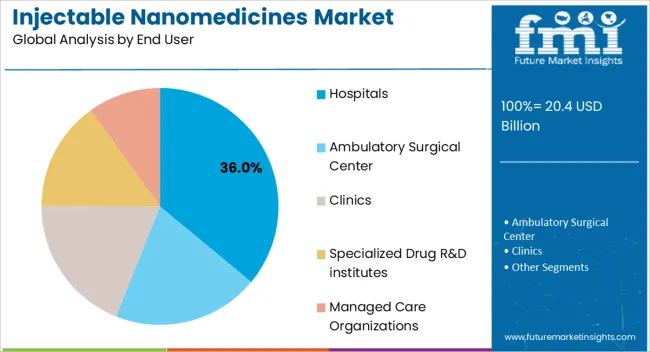
The hospitals end-user segment is anticipated to hold 36.00% of the Injectable Nanomedicines market revenue share in 2025, establishing it as the largest end-use category. This leadership is being driven by hospitals’ role as primary treatment centers for high-complexity therapies, including oncology, infectious diseases, and autoimmune disorders. Hospitals provide the necessary infrastructure, trained personnel, and monitoring capabilities required for the administration of injectable nanomedicines, ensuring patient safety and optimal therapeutic outcomes.
The growth of this segment has been further supported by increasing hospital investments in advanced drug delivery technologies, the expansion of oncology departments, and the integration of specialized infusion centers. Hospitals also benefit from established procurement channels, bulk purchasing capabilities, and structured treatment protocols, which facilitate widespread adoption of injectable nanomedicines.
The rising demand for personalized medicine and evidence-based treatment strategies has further reinforced the preference for hospital-based administration As healthcare systems continue to prioritize effective and precise therapies, the hospital segment is expected to maintain its leading role, supporting broader market growth in the coming years.
Nanomedicines belong to a niche field - where nanotechnology is combined with pharmaceuticals and other biomedical sciences. Injectable nanomedicines, if manufactured properly, can emerge as medicines with higher efficacy and safer toxicology profiles. Injectable nanomedicines can be a functional in many clinical cases for drug delivery and drug formulation. Currently nanomedicines account for a small revenue share in the entire nanotechnology based nanomaterial market- as nanomaterial is used in most of the working sectors. The rise of injectable nanomedicines is projected to lead to better outcomes and medicines for therapeutic areas such as cancer, CNS disease, cardiovascular disease and infection control. Nanotechnology is used in in vivo imaging, in vitro diagnostics, active implants and biomaterials.
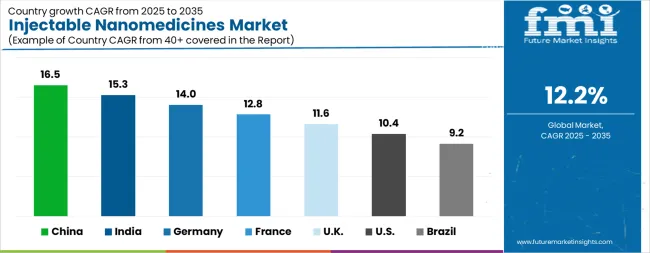
| Country | CAGR |
|---|---|
| China | 16.5% |
| India | 15.3% |
| Germany | 14.0% |
| France | 12.8% |
| UK | 11.6% |
| USA | 10.4% |
| Brazil | 9.2% |
The Injectable Nanomedicines Market is expected to register a CAGR of 12.2% during the forecast period, exhibiting varied country level momentum. China leads with the highest CAGR of 16.5%, followed by India at 15.3%. Developed markets such as Germany, France, and the UK continue to expand steadily, while the USA is likely to grow at consistent rates.
Brazil posts the lowest CAGR at 9.2%, yet still underscores a broadly positive trajectory for the global Injectable Nanomedicines Market. In 2024, Germany held a dominant revenue in the Western Europe market and is expected to grow with a CAGR of 14.0%.
The USA Injectable Nanomedicines Market is estimated to be valued at USD 7.5 billion in 2025 and is anticipated to reach a valuation of USD 20.2 billion by 2035. Sales are projected to rise at a CAGR of 10.4% over the forecast period between 2025 and 2035. While Japan and South Korea markets are estimated to be valued at USD 1.1 billion and USD 699.0 million respectively in 2025.
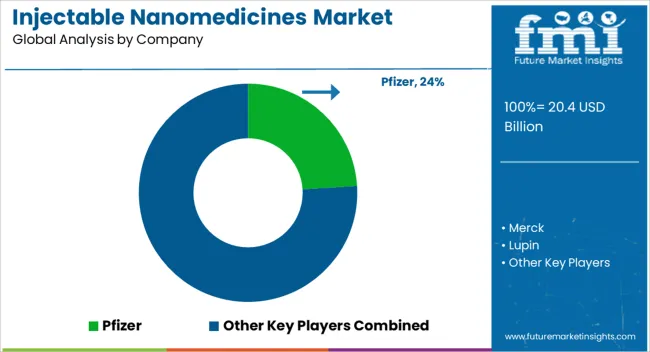
| Item | Value |
|---|---|
| Quantitative Units | USD 20.4 Billion |
| Drug Type | Liposomes, Micelles, Nanocrystals, Polymeric Nanoparticles, Metallic Nanoparticles, Mesoporous Silica Nanoparticles, and Others |
| Application | Cancers, Central Nervous System Diseases, Cardiovascular diseases, Infection Control, Inflammatory Diseases, and Others |
| End User | Hospitals, Ambulatory Surgical Center, Clinics, Specialized Drug R&D institutes, and Managed Care Organizations |
| Regions Covered | North America, Europe, Asia-Pacific, Latin America, Middle East & Africa |
| Country Covered | United States, Canada, Germany, France, United Kingdom, China, Japan, India, Brazil, South Africa |
| Key Companies Profiled | Pfizer, Merck, Lupin, Pacira Pharmaceuticals, Celgene Pharmaceutical, Amgen, Janssen Biotech, Hoffmann-La Roche, Teva Pharmaceutical Industries, and Bausch & Lomb |
The global injectable nanomedicines market is estimated to be valued at USD 20.4 billion in 2025.
The market size for the injectable nanomedicines market is projected to reach USD 64.6 billion by 2035.
The injectable nanomedicines market is expected to grow at a 12.2% CAGR between 2025 and 2035.
The key product types in injectable nanomedicines market are liposomes, micelles, nanocrystals, polymeric nanoparticles, metallic nanoparticles, mesoporous silica nanoparticles and others.
In terms of application, cancers segment to command 32.0% share in the injectable nanomedicines market in 2025.






Our Research Products

The "Full Research Suite" delivers actionable market intel, deep dives on markets or technologies, so clients act faster, cut risk, and unlock growth.

The Leaderboard benchmarks and ranks top vendors, classifying them as Established Leaders, Leading Challengers, or Disruptors & Challengers.

Locates where complements amplify value and substitutes erode it, forecasting net impact by horizon

We deliver granular, decision-grade intel: market sizing, 5-year forecasts, pricing, adoption, usage, revenue, and operational KPIs—plus competitor tracking, regulation, and value chains—across 60 countries broadly.

Spot the shifts before they hit your P&L. We track inflection points, adoption curves, pricing moves, and ecosystem plays to show where demand is heading, why it is changing, and what to do next across high-growth markets and disruptive tech

Real-time reads of user behavior. We track shifting priorities, perceptions of today’s and next-gen services, and provider experience, then pace how fast tech moves from trial to adoption, blending buyer, consumer, and channel inputs with social signals (#WhySwitch, #UX).

Partner with our analyst team to build a custom report designed around your business priorities. From analysing market trends to assessing competitors or crafting bespoke datasets, we tailor insights to your needs.
Supplier Intelligence
Discovery & Profiling
Capacity & Footprint
Performance & Risk
Compliance & Governance
Commercial Readiness
Who Supplies Whom
Scorecards & Shortlists
Playbooks & Docs
Category Intelligence
Definition & Scope
Demand & Use Cases
Cost Drivers
Market Structure
Supply Chain Map
Trade & Policy
Operating Norms
Deliverables
Buyer Intelligence
Account Basics
Spend & Scope
Procurement Model
Vendor Requirements
Terms & Policies
Entry Strategy
Pain Points & Triggers
Outputs
Pricing Analysis
Benchmarks
Trends
Should-Cost
Indexation
Landed Cost
Commercial Terms
Deliverables
Brand Analysis
Positioning & Value Prop
Share & Presence
Customer Evidence
Go-to-Market
Digital & Reputation
Compliance & Trust
KPIs & Gaps
Outputs
Full Research Suite comprises of:
Market outlook & trends analysis
Interviews & case studies
Strategic recommendations
Vendor profiles & capabilities analysis
5-year forecasts
8 regions and 60+ country-level data splits
Market segment data splits
12 months of continuous data updates
DELIVERED AS:
PDF EXCEL ONLINE
Injectable Osteoarthritis Microspheres Market Size and Share Forecast Outlook 2025 to 2035
Injectable Drug Industry Analysis in North America Forecast Outlook 2025 to 2035
Injectable Anti-Wrinkle Treatment Market Size and Share Forecast Outlook 2025 to 2035
Injectable Thyroid Drug Market Size and Share Forecast Outlook 2025 to 2035
Injectable Liquid Filling Machines Market Size and Share Forecast Outlook 2025 to 2035
Injectable Drug Market Analysis - Size, Share, and Forecast Outlook 2025 to 2035
Injectable Potassium Phosphate Market – Growth & Forecast 2024 to 2034
Injectable Drug Delivery Market Analysis – Growth & Trends 2024-2034
Injectable Cocoa Fillings Market
Injectable Drug Packaging Market
Injectable Benzodiazepine Market – Trends, Growth & Forecast 2022-2032
Injectable Bulking Agents Market
Global Non-injectable Insulin Market Insights – Size, Trends & Forecast 2024-2034
Lipid Injectable Market
Spinal Injectable Market Size and Share Forecast Outlook 2025 to 2035
Generic Injectable Market Report - Growth, Demand & Forecast 2025 to 2035
Global Sterile Injectable CDMO Market Analysis – Size, Share & Forecast 2024-2034
Glucagon Injectable Market
Ophthalmic Injectable Market Size and Share Forecast Outlook 2025 to 2035
Veterinary Injectable Devices Market Size and Share Forecast Outlook 2025 to 2035

Thank you!
You will receive an email from our Business Development Manager. Please be sure to check your SPAM/JUNK folder too.
Chat With
MaRIA